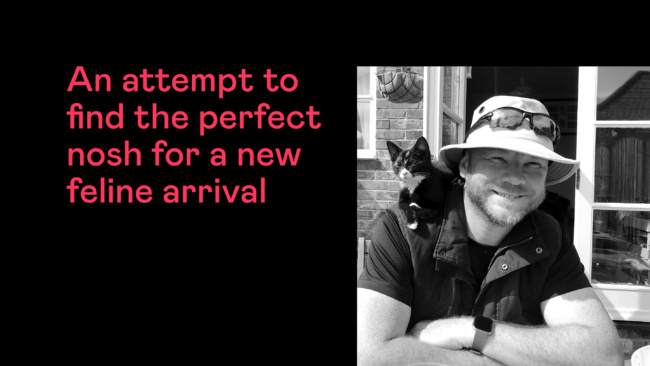
Branding lessons from a strategist’s adventure to find the perfect food for his four-legged friend.
Written by: Rob Allen, Strategy Partner
Two years ago, I wrote about the new brand decision-making that resulted from getting a cat. I recorded my journey – and the somewhat exasperated accompanying journey taken by my wife – as I tried to decode the messages in an unknown category. Waxie – ‘The Catsumer’ – eventually found her brand through a combination of cat image personality, and eloquent ‘consumer feedback’ i.e. being sick on the floor when we picked badly.
Waxie is still extremely picky about her food, or as she puts it, a brand loyalist. She’s been promoted from ‘The Cat’ to ‘Head of Mousing Services’ – a role she performs with a somewhat distressing level of enthusiasm.
But change was afoot, with the addition of a new consumer in the household: a D-O-G. Our new segment is a red Lab/Spaniel cross called Mortimer. His attributes are keen, hungry, and still hungry. Messaging is consistently centered around ‘you’re not eating all of that by yourself are you?’
So once again I was faced with a new brandscape to explore. Although this is a category where DTC has exploded, I wanted to smell the offal. So it was off to the pet store to re-enter the valley of bewilderment. But this time I had with me a smidgen of confidence. I’d managed to keep a cat alive, thus proving I could read some labels and open a tin. But this branding journey would be easier with dog brands? Right?
Wrong.
Walking down a cavernous 50 meter aisle, towering bags of feed loomed, shouting messages at me from all directions. Dog food was clearly a bulky business, with bags only slightly less gigantic than the ones for horses. Ignoring the curiosity value of pot-bellied pig food, I began to review the dog food section.
Choosing by identity worked well for the cat, but the sheer variety of dogs bewildered the mind: small dogs, big dogs, floppy eared dogs, terrier dogs, old dogs, young dogs, sensitive dogs, slightly older but small dogs, eager dogs, dogs that run around a lot… the sheer complexity and minutiae were boggling.
But one message stood out for me: Working Dogs. Proud, pointy-nosed, noble, sleek creatures, these hounds were a mere tail’s length from the aspirational dog’s Ubermensch – the wolf. These were clearly the…er…Top Dogs.
In my mind, these uber-dogs then successfully de-positioned every other dog ambassador and their brand. Oh so you’re not a working dog, they seemed to imply, so you’re a lazy useless dog then? I immediately felt performance pressure on behalf of our slightly dappy tail-chasing pup. Even though he was scared of the neighbor’s sheep, surely he’d be a working – a proper – dog? The first brand identity decision was set.
With Mort’s identity clear, the enormous portfolio shrunk to a more manageable consideration set. Then it was time once again for that fun branding game of ‘Assess the Claims’. In which a hapless and uneducated consumer attempts to judge competing proof points of efficacy, taste, and nutrition, based on nothing more than their own prejudices…ultimately getting completely befuddled and falling into the arms of a brand they trust.
The big debate in the dog nutrition world seemed to be ‘raw or cooked’? Raw – as nature intended it, as if your dog had just hunted down his own mammoth and tucked straight in – but presented in little cubes for your convenience. Cooked – better for young Snookie’s tum tum, without the risk of any nasty bacteria upsetting him. Pah, no choice necessary for a real dog then.
Getting rather carried away with my dog/wolf analogy, I examined the brand ‘Crave’. The black packaging, staring amber eyes, nutritional quantification, and highly evocative name, told me this was a brand for the bro-hound. Hounds who hang out in the gym’s weights section, lapping protein shakes and effortlessly lifting huge Bison bones.
Although this image was somewhat undermined by the cutesy Labrador silhouette gazing adoringly at the wolf. Presumedly this was added by the Brand Manager in a last-minute panic, suddenly realizing his target market was a Rover in a Rangie, not White Fang and his pack of ravening lumberjack maulers.
I looked around for trusted familiarity. And sure enough, there was premium associative naming’s old favorites, Pedigree and Winalot. Alas Pedigree felt a little like a sadly neglected old toy, a huge dusty slab of discounted tins in a forgotten corner of the store.
Dog food naming had clearly been following the same associative to abstract curve many categories have followed, because the brand next to Pedigree was an eye-catching sky-blue brand called Dylan. Dylan was a perky Collie – a working dog of course – but was he called Dylan? Thanks to the rounded type I’d mis-read it and thought the brand was Dylon. Which is Welsh for ‘like a lion’. Perfect for your sheep hustling working dog. However, Dylan means ‘son of the sea’. Which is somewhat less appropriate unless he was planning to herd seals. It’s possible I may have been overthinking the naming.
The next brand for consideration was Harringtons. Classic, understated. It was offering ‘the natural choice’. But perhaps I’d be better with Wainwright’s because ‘it’s in our nature’. Although James Wellbeloved were, they said, ‘naturally healthy’, and I was assured by Hi Life that ‘it’s only natural’. Hang on… if this was really important, I’d pick a brand name like ‘Nature’s Variety’, or maybe ‘Nature’s Menu’. Although I could start gently, with ‘Step up to Naturals’, or trust Purina’s promise that their offer is ‘made with natural ingredients’. And now I can’t see the wood for the marketeer.
Feeling somewhat beaten around the head by this ‘naturalness’ trying too hard competition, I took refuge in Hill’s ‘Science Plan’. This did not sound tasty. But it did display a stark white confidence in a shiny NASA style pack, which – after all the verbal ransacking of Mother Nature – was strangely appealing in its lack of appeal.
The same was true of ‘Butcher’s Nourishing Food for Dogs’. I got briefly distracted by whether Butchers were actual butchers, or whether the founder found brand destiny through nominative determinism. There was something reassuring about the old school solid tins offering delightful 1970s dinner party treats like ‘tripe loaf’. Ronseal branding for dogs. They also hailed their support for British farming. As someone who lives in a village surrounded by farmers, this localness attribute resonated.
I examined Step up to Naturals in more detail, and was somewhat disturbed by the claim (in funky hand drawn typography), that the brand offered ‘Wholesome nutrition that feeds body, mind and spirit’. This sounded worryingly like a brand for the kind of long-haired hippy dog that gets bullied by the Crave Bro-Hounds. I didn’t want that to happen to Mort.
Vacillating between ubiquity and overclaim, the verbal identities were not getting me anywhere. I decided it was better to go with visuals. And on this, Wainwright’s stood out. A warm-coloured illustration showed a man and his dog gazing out over the countryside. This went straight to the heart of having a dog for me. Companionship and simple country living. I was sold!
Except I wasn’t. Because I’d made (another) classic marketing error. I was not the target audience. My Wife – once again tiring of me bleating on about my interminable branding ‘journey’ – had turned to expert opinion in the shape of the breeder. Who told us that as Mort was still a pup, we should stick to the brand he was used to, so the change didn’t cause a stomach upset.
So at least for now, Mort’s a Brand Ambassador for Natures Menu. And as he scoffs it down in about 5 seconds per bowl, I’d say the brand is delivering on its proposition of ‘The best food for your best friends’.
The branding lessons
- Verbal identity matters. Whilst all of the brands were differentiated visually, a narrow set of linguistic phrases made it harder for the brands to be distinctive.
- Emotional distinctiveness counts as much as functional. A relevant and evocative personality helps guide identity and preference.
- Brands don’t just have target audiences; they have audience ecosystems. Partners, experts, friends, all have an impact on decision making.
- Purpose stands out. Whilst the focus of the category is firmly on the dog, the broader backing farmers claim immediately jumped out.
- Brand trust matters. It’s difficult to judge between claims. A known and trusted brand gets you a long way into consideration

